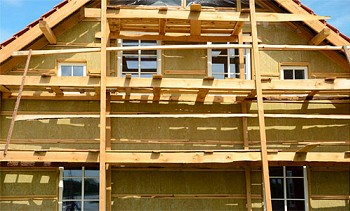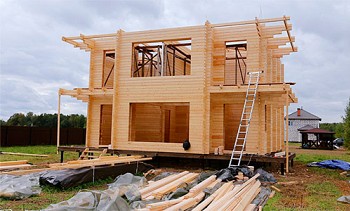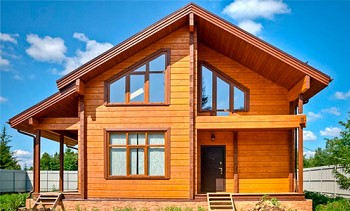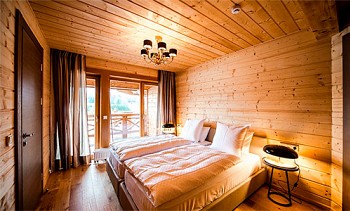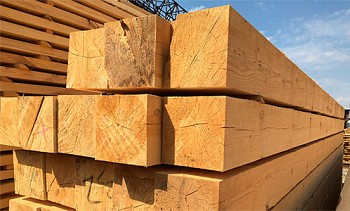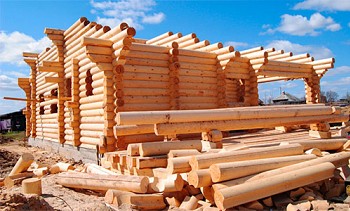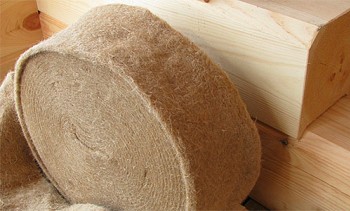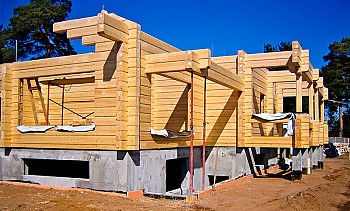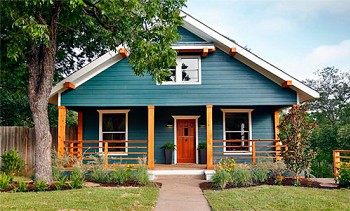After a break, the wood again begins to gradually gain a leading position in the market of materials for low-rise construction. The tree is ecologically and aesthetically attractive, but at the same time it has a number of disadvantages. To minimize the number of the latter, it is necessary to approach with a full responsibility to the question of the choice of material for construction. Today we will talk about three varieties of lumber used for the construction of wooden houses, namely: sawn (non-profiled) timber, solid profiled timber, glued profiled timber.
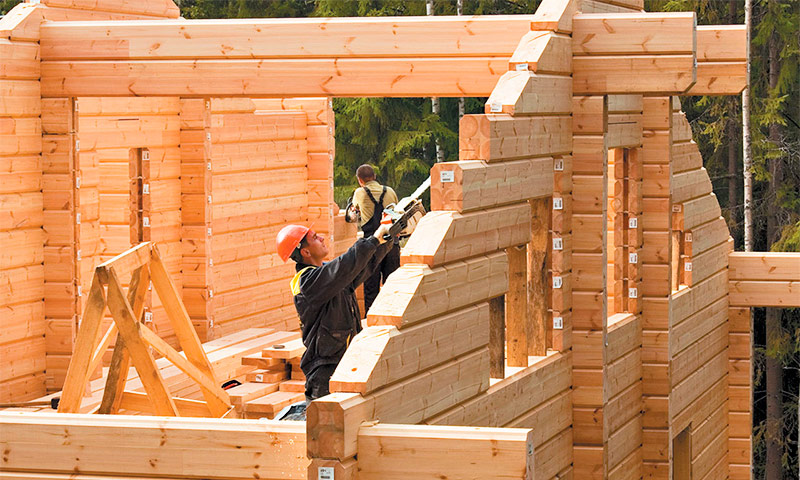
Content:
What is each type of timber
The source material for the manufacture of any timber is usually coniferous wood (spruce, pine, larch, cedar). It would seem that if the starting point is one, then at the finish we should have something very similar. Then in connection with which so many questions arise? Which is better - ordinary timber or glued timber? Are they really very different from each other, or is this some sort of another marketing ploy? To understand this, first you need to get at least a general idea of what each of the considered types of timber is.
Sawn timber
Sawn (edged, non-profiled) timber is the cheapest type of timber. The technology of its production is extremely simple. Four edging is cut from a log (in other words, lateral slabs are cut from it), the result is a square (150 × 150 mm) or rectangular (150 × 200 mm) beam. The standard material length is 3 or 6 m. Non-profiled timber is not subjected to special drying. Preservation of the natural moisture content of the material makes the process of its preparation as simple as possible, and the cost is low.
Previously, non-profiled timber was used in the construction of houses quite often. Today, as a rule, they resort to its use only in those cases when they want to save on the cost of the material. In general, the low price of edged timber is almost its only advantage, but it has almost all the disadvantages inherent in wood.

Profiled Solid Bar
Profiled solid timber - material worthy of attention. Due to the fact that it is devoid of a number of disadvantages of edged (unshaped) timber, and its price is not prohibitively high, a shaped beam is most often used in the construction of wooden houses.
A profiled beam is produced in the factory, where using special equipment to ensure the ideal geometry of the product and the accuracy of its linear dimensions, the log is rounded off on four sides, and then special lock joints are made in the resulting beam. At the output, we have a profile of a complex section, accurate to the millimeter, corresponding to the given parameters. There are several types of castle joints, but the most common are Finnish (tenon groove) and German (comb) profiles.

Finnish profile.

Comb.
Due to the presence of spikes and grooves, two adjacent beams are tightly joined together, leaving no cracks, and securely fixed. The house is assembled as a children's designer - quickly and easily. Its even and smooth walls look very beautiful.
All available profiled timber on the market in terms of humidity is divided into two categories. There is a bar of natural humidity and chamber drying.A high-quality chamber drying bar is not cheap, but the walls from it do not deform, and the house practically does not shrink, which means that it can be settled right after the construction is completed.
Profiled glued beam
Profiled glued beam according to its production technology is fundamentally different from the first two types of timber considered. The log is sawn into boards that go through the stage of chamber drying, treated with antiseptics and flame retardants, and then glued using a special adhesive based on PVA. The resulting monolithic beam consists of boards of different thicknesses, and they are stacked so that the direction of the fibers in each subsequent layer changes to the transverse. Due to this multidirectionality of wood fibers in the glued beam massif, it is stable to damping and drying out, does not deform with time, has a hardness increased by 50-70%, and is not inferior to brick in strength.

The number of layers in the beam can vary from 2 to 5 - it all depends on the desired thickness of the final product. Finally, at the final stage of the process, the beam itself with one or another type of castle joint is cut out of the obtained glued beam with jewelry precision.
This smooth, durable and high-quality material can be successfully used in "fast" construction, since the construction built from it practically does not shrink. Since this is a profiled beam, the house frame is assembled quickly, and the gaps between adjacent beams (and, consequently, the heat loss of the house) are minimal.
Which beam is better for building a house in the country or building a country cottage? Each variety has its own advantages and disadvantages that affect the final cost of construction, strength and durability of the structure, the amount of work at the stage of building the house and during its subsequent operation, etc. Decide what is the most priority for you, and then you You can choose the most suitable material for you.

Material and construction costs
For most people, the financial side of a given issue, as a rule, is paramount. And we will begin our review by considering precisely the price characteristics of different types of timber: what is the point of discussing the advantages or disadvantages of building material if it is simply too expensive for you.
Cost and availability are the main advantages of a conventional non-profiled timber. It is not difficult to buy such material - you can find it in any building materials market. The average cost of a cubic meter of edged timber varies from 5500 to 6500 rubles.
Inexpensive, you say, multiplying these numbers by the amount of material you need? But do not forget that the built house will need to be brought to mind, to make it suitable for living. And here it is from you that new financial investments will be required, and considerable.
Firstly, the geometry of the edged beam of the lowest price category is very far from ideal. It is simply impossible to build walls from it without cracks. Hence the need for additional insulation.
Secondly, the cross-sectional dimensions of such a beam and the flatness of the saw cut do not correspond much to GOST standards, because of which the walls of the building turn out to be uneven, there are large differences in the location of the crowns, the seams are located at different heights. In a word, such a house looks very ugly, and to give it a complete look requires additional external and internal decoration (usually the walls are lined with clapboard, blockhouse, etc.).

Log from sawn timber.
Evaluated the extra costs? Still consider edging beams a cheap material?
Of course, you can minimize problems by choosing a higher quality timber, but the cost of the latter may be close to the cost of a profiled timber.
The price of a profiled beam that has passed through the process of chamber drying ranges from 9,000 and up to 28,000 rubles.per cubic meter, depending on the type of wood (the most expensive material is from larch). Of course, you can try to save and buy a bar of natural humidity, the price of which is one and a half times lower. However, by doing so you will lose many of the advantages of a profiled beam and gain a bunch of problems, the solution of which will result in a considerable amount. The construction of a high-quality dry shaped beam has a neat presentable appearance and does not need to be finished with facing material. Serious additional work to warm the house does not threaten you.
Glued beams are quite expensive material, and this is perhaps its main drawback. Its average cost is 25,000 rubles. per cubic meter. However, additional costs for the insulation of the building or its external decoration from you will not be required.
A house from glued beams will cost you 2-2.5 times more expensive than the same project from a solid profiled beam and 3-4 times more expensive than a building from edged beams. However, in this case we are only talking about the cost of the material. If we take into account the costs of additional work to bring the building to a state of suitability for living, we can expect that the difference in the final cost of all three “huts” will be minimal.
The complexity and speed of the construction of the building
Non-profiled timber, modern developers are using less and less. The reason lies in the excessive complexity of working with this material. Laying such a beam, evenly and so that there are no gaps, is quite difficult. At the construction of the frame, the work does not end. About a year later, when the process of shrinkage of the building ends, you will have the laborious stage of piercing cracks and large cracks, as well as the obligatory decorative decoration of the walls, not only from the inside, but also from the outside.
The frame of the house from the profiled beam is assembled quickly and easily - as a designer. However, if you decide to use natural humidity timber for construction, you have to take a technological break for 10-12 months. During this time, the timber will dry, the structure will sit down, and it will be possible to begin finishing work.

The speed of building a house from glued beams is even higher than from a conventional profiled one, thanks to clearly calibrated dimensions and well-fitted connecting elements. The shrinkage and shrinkage of the glued-beam construction is minimal, which makes it possible to successfully use this material for “quick” construction.
To build a house from a profiled beam, both ordinary and glued, is easy and quick, which can not be said about structures made of edged timber.
Which house is warmer
No one, for sure, will argue with the fact that the house should be warm and cozy. And warm, not only figuratively, but also literally. In Russia, where winters are quite cold and even harsh in most regions, the question of the heat-saving characteristics of buildings does not seem far-fetched. Which is better - glued beam or profiled - from this point of view? Which is better able to retain heat, ensuring the absence of drafts?
In the walls of the house from a non-profiled beam due to the absence of the last grooves and spikes there will be many gaps. Shrinkage of the building will greatly aggravate this problem. Of course, when building a house from edged timber, all the cracks are necessarily filled with jute, but in most cases this is not enough. Without additional high-quality wall insulation, few will dare to winter in such a hut blown by all the winds.

The use of profiled timber in the construction avoids cracks, which means that the blown through walls will be minimal. Such a house will be warm enough, but in order to guarantee its future residents safe from winter frosts, the joints between the joints of the timber are reliably sealed with a heater made of special material, the consumption of which, however, is minimal.
Glued beams have the best thermal insulation qualities.The gaps between the profiles in this case are minimal, and, consequently, the heat loss is lower. The beam can be laid even without insulation. However, experienced builders here do not neglect this stage.
The best thermal insulation qualities are glued beams. In the case of glued beams, it is possible to choose a material of such a thickness that no additional insulation is needed. But it all depends on the region of construction, sometimes even glued beams require insulation. The house, built from edged timber, in practice turns out to be the most purged, and if you do not do additional insulation, it will be very cold in winter.
Environmental Safety
A house is, first of all, a place where we feel completely safe. And the question in this case is not only about the fact that the house should be strong and reliable enough so that we can not be afraid of the visit of uninvited guests or the revelry of the elements. Being in the native walls, we should not be afraid for our own health.
Wood has always been and still remains a symbol of environmental friendliness. It is quite predictable that houses built from edged or profiled timber will be out of competition from the point of view of environmental safety. The ventilation of such a house is natural (subject to the use of natural sealing materials, for example, jute), it breathes very easily, and the humidity in the room will always be optimal.
The use of glued beams in the construction of residential buildings gives rise to a lot of controversy and discussion. Firstly, glue is used in the production of such a beam. As a rule, PVA-based adhesives are used for these purposes, which, unlike phenol-formaldehyde resins used in the manufacture of wood-based panels, is considered harmless to health and the environment.

Despite the fact that the adhesives used correspond to different standards, such a timber from the point of view of environmental friendliness loses to the usual one, in which any adhesives are absent in principle. In addition, it will not be amiss to ask yourself a question: are you sure that the manufacturer of the timber, the consignment of which you intend to purchase, did not violate the technology to reduce the cost / speed up the process?
Secondly, in the production of glued beams, lumber is impregnated with various antiseptic, insecticidal, flame retardant and other compounds. Of course, the walls of a house built even of edged or profiled timber, you will have to handle these protective impregnations in order to prevent its premature destruction as a result of adverse external factors. However, there you will apply the protective compounds for the most part to the external walls, and here the timber is saturated with them in their entirety.
Thirdly, due to the tight joining of the beams and the absence of gaps between them, due to the multidirectional arrangement of wooden fibers and the use of glue, the natural air exchange in the house from glued beams is impaired, the vapor permeability of the walls is reduced. To improve the indoor microclimate, it is necessary to equip the house with wall inlet valves or a forced ventilation system.
In a word, despite the compliance of glued beams with European standards and Russian GOSTs, there is still room for doubt. If your family has small children, allergies, asthmatics, people with other chronic diseases, give preference to an edged beam or a profiled beam, which is clearly better in terms of clean air inside the house.
Edged and profiled timber are the leaders in the list of environmentally friendly materials. In this regard, many claims can be made to glued beams.
Exacting care during operation
Natural factors, primarily rainfall, solar radiation, seasonal temperature fluctuations, have a detrimental effect on the state of wood.Prevent decay, fungus or mold, reduce the attractiveness of wood for insects and rodents, reduce the likelihood of a fire, etc. regular treatment of wooden walls of the building with antiseptics, flame retardants, insecticides and other protective impregnations will help. Caring for wood takes a lot of time and energy, so I want to choose a material that does not require you to intervene too often.

Non-profiled timber at the stage of harvesting is not subjected to special drying, which means that the probability of wood damage by a fungus is quite high (according to experts, about 15% of the material sold has this problem). In addition, as a result of natural shrinkage of the beam and shrinkage of the structure made of it, the wood cracks, and the cracks between the crowns increase, which, among other things, leads to a decrease in the thermal insulation of the house. This means that after some time you will have to re-caulking the cracks, and fill the cracks in the wood, for example, with sealant.
When used for the construction of profiled timber, many problems can be avoided. The walls in this case are very smooth, the profiles are as close to each other as possible, the shrinkage of the structure is insignificant. From all this it follows that the probability of formation of cracks is reduced to almost zero, which means that water does not get into the wall, and rotting of the material from the inside is excluded. However, wood remains wood, and without treatment with antiseptics, insecticides, flame retardants, wait for mold, fungus, invasion of the grinder beetle or (God forbid, of course) fire.
Many of the problems listed above are not familiar to owners of glued beam houses, but all thanks to the optimum moisture content of the material and its impregnation with special compounds at the manufacturing stage. The glued beam almost does not deform and does not rot. Even such wood burns much worse than ordinary wood. The house built of glued beams for many years will delight the eye with its presentable appearance. Maintenance of the structure will be reduced mainly to checking the condition of the timber. To process wood with special compounds in order to prevent the negative impact of external factors you will have to be much less likely than in the first two cases.
Periodic processing with special protective compounds is necessary for all types of timber. But edged or profiled timber will require more frequent intervention from you than glued.
The need for additional finishing materials
The appearance of the structure from the edged (non-profiled) timber is more than unpresentable. Seams that are the result of imperfect fit of wooden elements to each other, and insulation in them are striking. In addition to this, when the walls shrink and the material shrinks, noticeable cracks appear in it. The only way to hide such a somewhat unsightly picture, spoiling the appearance of the house, is additional wall decoration, not only internal but also external. Start finishing should be no earlier than a year later, when the shrinkage of the house ends.
Profiled timber is more aesthetic. The presentable and neat appearance of the walls erected from it reduces to zero the need for additional finishing with facing materials. Even homeowners refuse to decorate walls (for example, painting), since wood, being a natural material, is very beautiful in itself (of course, provided that its surface is perfectly flat and smooth). However, in a solid wood (and profiled timber is no exception), cracks may appear over time. This means that after a few years you may have a desire to cover the inner surfaces of the walls with some kind of facing material.
Due to the peculiarities of production technology, glued beams are devoid of many of the disadvantages inherent in wood. The house will not lose its presentable appearance even after years.

Unlike a solid profiled beam, glued is not subject to cracking during operation. Its ideal surface does not need any additional processing, including facing with finishing materials.

Use for the construction of profiled and even more so of glued beams allows you to exclude the time-consuming and expensive stage of finishing work. The edged beam, alas, turned out to be an outsider in this "beauty contest".
Durability of the building
Having spent a lot of effort on building and making serious financial investments, we, of course, want the new house to stand for as long as possible. What material to choose so that the house serves not only us and our children, but also grandchildren, and maybe even great-grandchildren?
Manufacturers convince that a house from an ordinary non-profiled beam will last more than 50 years, from a profiled one - up to 100 years, and from a glued one - even up to 150. Here there is a quite reasonable reservation: material preparation, house construction and its maintenance during operation should be carried out technologically correctly.
Non-profiled timber is characterized by increased cracking during wood drying and home shrinkage (the latter is on average 5–7%). Due to the presence of stresses arising during the drying process, the beam “leads”. Defects formed during the shrinkage of the building, not only worsen the appearance of the house, but also reduce its thermal characteristics. In addition, any crack is a place of accumulation of rainwater, the subsequent growth of colonies of microorganisms and, as a result, acceleration of wood decay processes.
The profiled beam, manufactured in the factory, is perfectly flat and durable, the beams fit snugly together. The structure assembled from such a beam will be quite strong, and its shrinkage is minimal and uniform. However, such a result can be obtained only if the timber is well dried out, otherwise the building will face deformation and great shrinkage. Unfortunately, some unscrupulous manufacturers often violate the technology of drying, and if you inadvertently get such low-quality material, your house will “lead” over time.
Glued beam practically does not deform, shrinkage of structures from it, as a rule, does not exceed 1-2%. In addition, at the manufacturing stage, glued beams are treated with special substances, so that they lose the inherent disadvantages of wood: such material does not decay and does not burn. Taking all these factors into account, it is possible to predict an increase in the service life of the glued beam structure.
A house made of edged timber will stand for at least 50 years. The service life of a building from profiled timber is two times, and from a glued one, three times longer.

